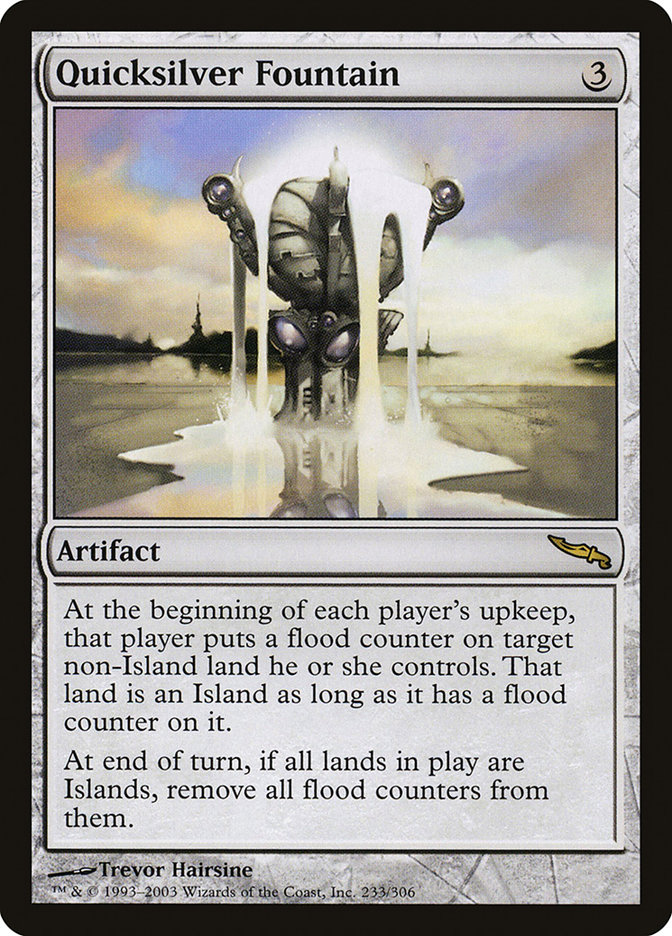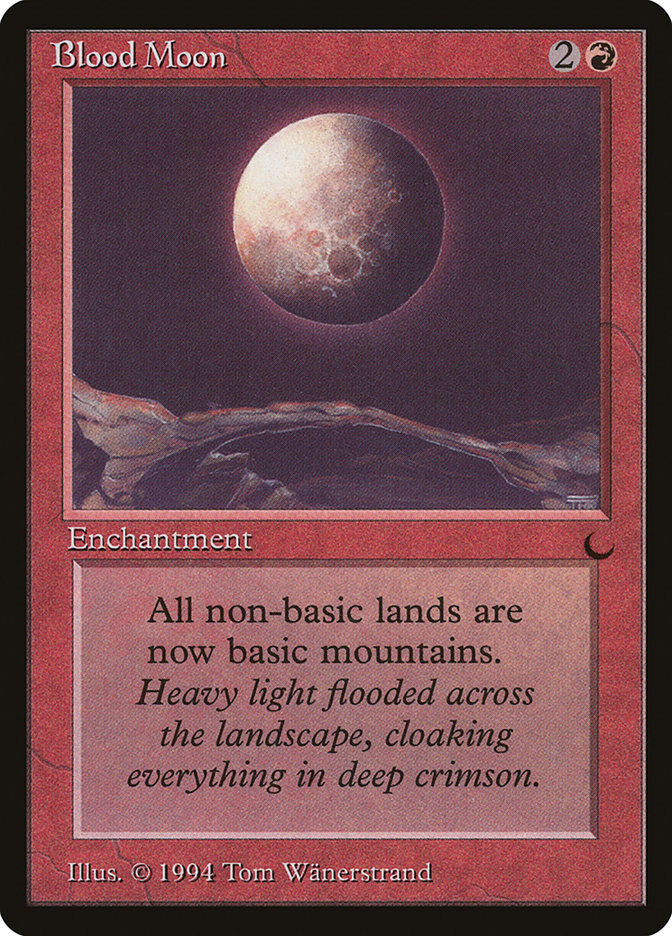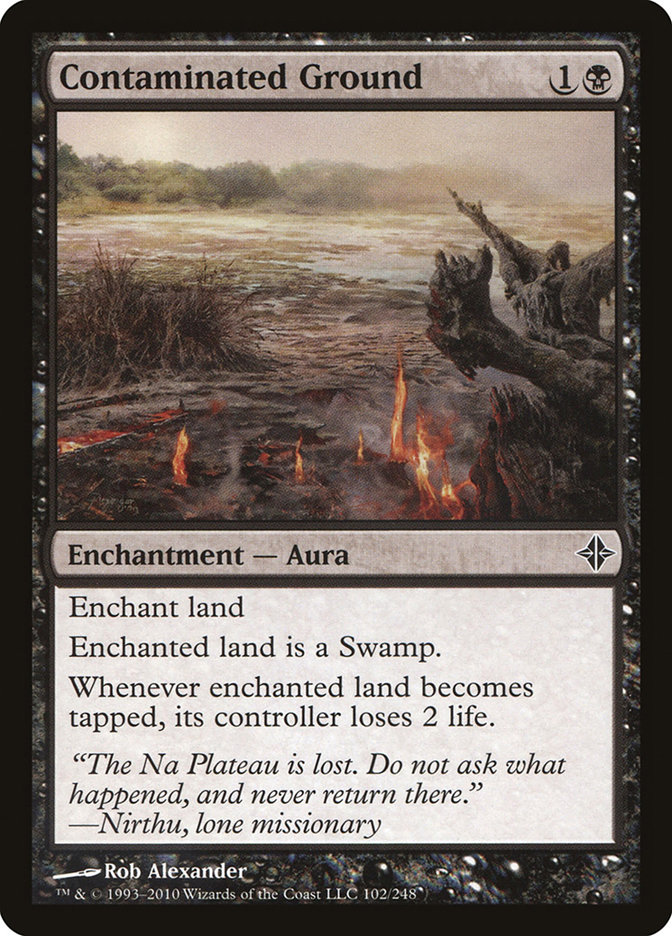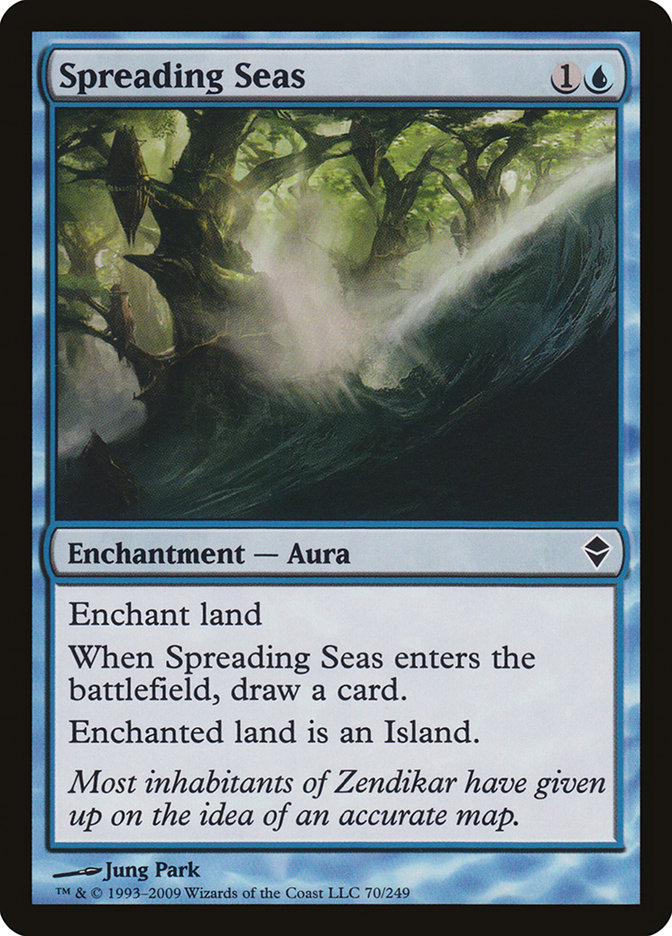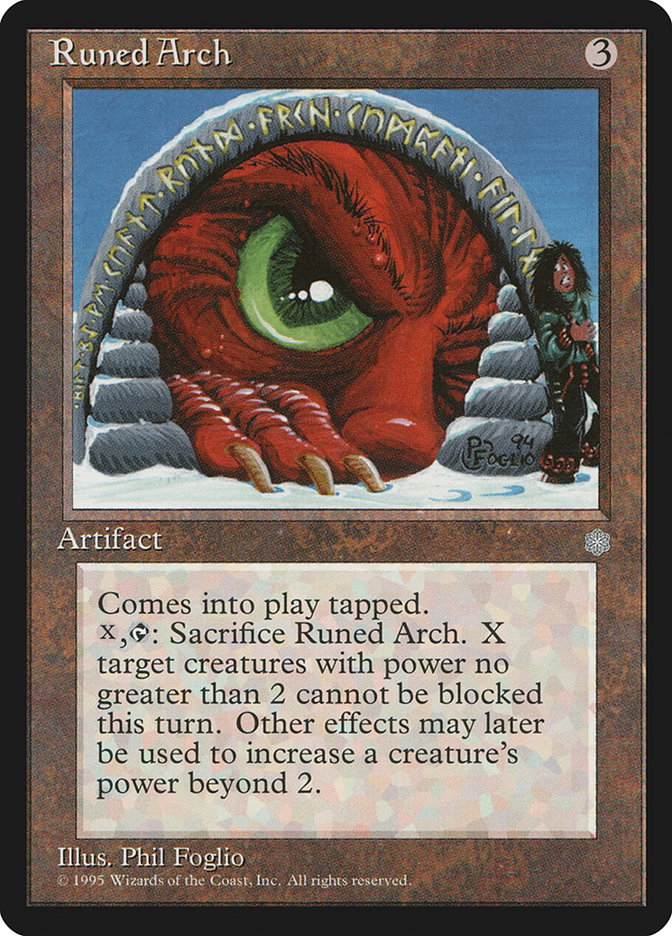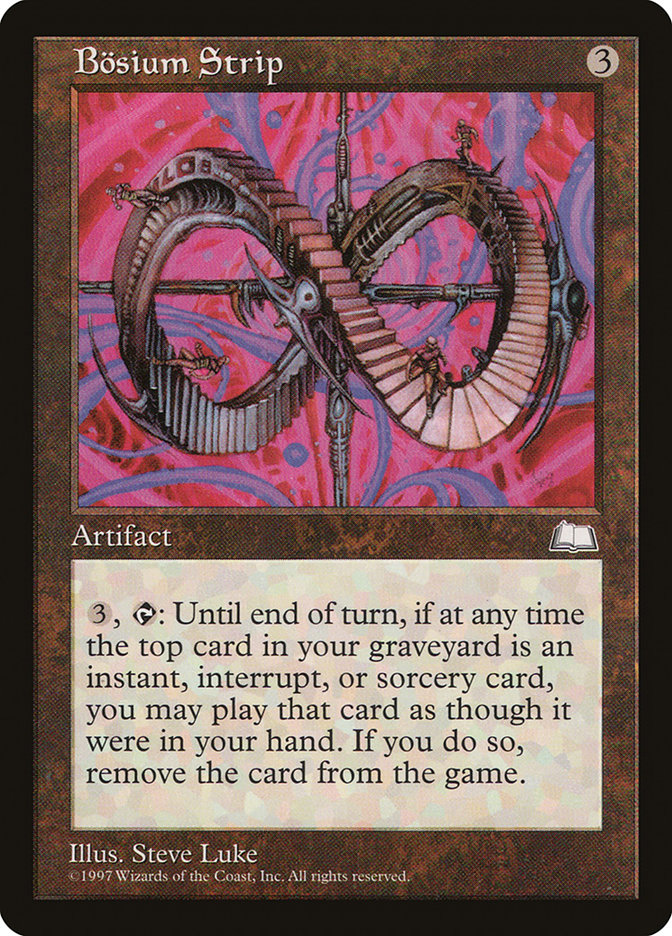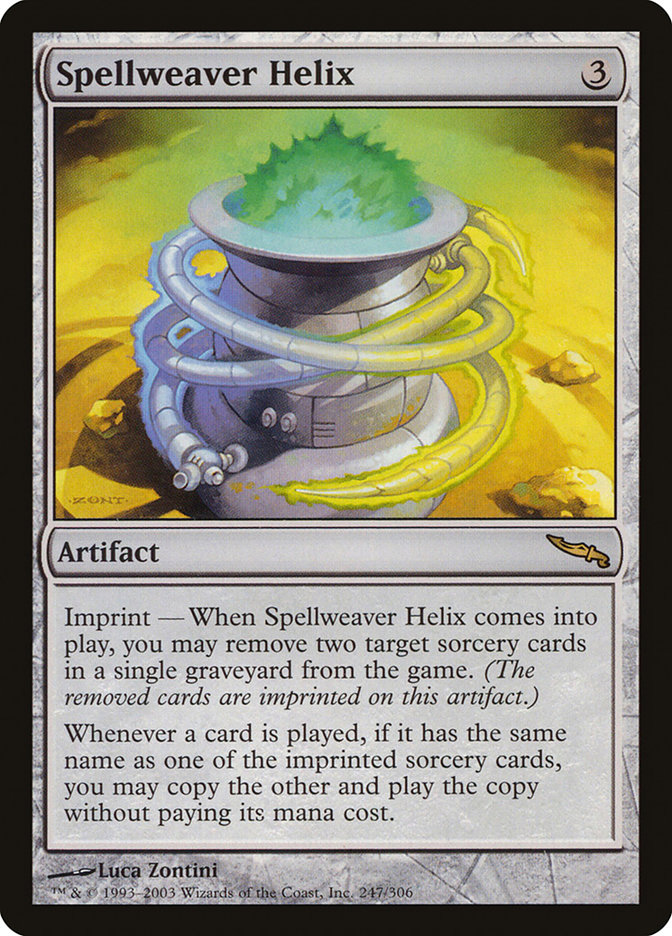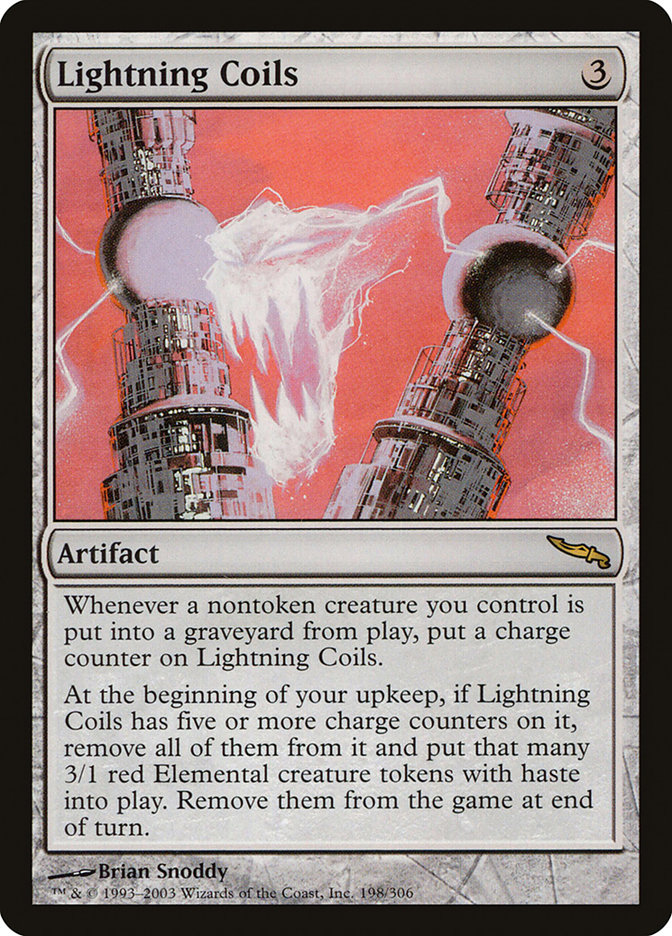Fuente de mercurio Carta MTG
| El coste de maná | |
| Costo de maná convertido | 3 |
| Rareza | Extraña |
| Tipo | Artefacto |
| Liberado | 2003-10-02 |
| Coleccione símbolo | |
| Coleccione nombre | Mirrodin |
| Coleccione código | MRD |
| Número | 233 |
| Frame | 2003 |
| Disposición | Normal |
| Border | Negra |
| Ilustrado por | Trevor Hairsine |
Texto de la carta
Al comienzo del mantenimiento de cada jugador, ese jugador pone un contador de inundación sobre la tierra objetivo que controle que no sea isla. Esa tierra es una isla mientras tenga un contador de inundación sobre ella. Al final del turno, si todas las tierras en juego son islas, remueve todos los contadores de inundación de ellas.
Cartas Similares
La Fuente de Mercurio Vivo aporta un estilo único de juego a la mesa de Magic: The Gathering con su intrigante habilidad de transformación de tierras. Destaca la esencia transformadora de cartas como Luna de Sangre, que también manipula tierras convirtiéndolas en Montañas. Sin embargo, la Fuente de Mercurio Vivo se destaca al dirigirse metódicamente a tierras individuales, convirtiéndolas gradualmente en Islas con cada mantenimiento, sin paralizar por completo las bases de maná de un oponente como hace Luna de Sangre.
Comparado con este patrón está Suelo Contaminado. Ambas cartas alteran el estado de las tierras, pero Suelo Contaminado lleva el aspecto de transformar cualquier tierra en una potencialmente dañina para su controlador, proporcionando dos colores de maná pero a un costo. Otro equivalente destacado es Mares Expansivos, que tiene un efecto similar de conversión a Islas junto con el beneficio de robar cartas. Sin embargo, la Fuente de Mercurio Vivo lleva este concepto más allá, impactando múltiples tierras a lo largo del juego.
Al evaluar los usos estratégicos e impactos de estas cartas, la Fuente de Mercurio Vivo claramente se sostiene por sí misma. Su habilidad continua de convertir tierras cada turno proporciona una amenaza persistente, convirtiéndola en una carta valiosa para estrategias de control en Magic: The Gathering. Es esta influencia gradual pero inevitable en el tablero lo que sitúa a la Fuente de Mercurio Vivo en una liga propia entre las cartas que alteran tierras.
Cartas similares a Fuente de mercurio por color, tipo y coste de maná
Aspectos positivos de la carta
Ventaja de cartas: La Fuente de Mercurio puede transformar sistemáticamente las tierras de tu oponente en Islas, interrumpiendo su base de maná y haciéndoles perder acceso a colores cruciales necesarios para lanzar hechizos.
Aceleración de recursos: Aunque no acelera directamente tus recursos, al convertir las tierras oponentes, controlas el ritmo y la flexibilidad de recursos del juego, dándote una ventaja indirecta.
Velocidad instantánea: Aunque la Fuente de Mercurio no opera a velocidad instantánea, la amenaza continua cada turno aplica presión constante, forzando efectivamente a los oponentes a jugar considerando la posibilidad de quedarse sin maná en cualquier momento.
Aspectos negativos de la carta
Requisito de descarte: Con la Fuente de Mercurio, no hay un requisito directo de descarte. Sin embargo, se necesita una estrategia bien planificada para maximizar sus beneficios, ya que potencialmente puede transformar tus propias tierras en Islas, lo que podría interrumpir inadvertidamente tu propia base de maná si no se utiliza cuidadosamente.
Costo de maná específico: La Fuente de Mercurio tiene un costo de maná específico de tres maná genérico, lo que significa que no restringe su inclusión en mazos multicolores. Sin embargo, en mazos que se ejecutan con curvas de maná ajustadas, dedicar tres manás a un artefacto que no impacta el tablero de juego inmediatamente podría no ser siempre la mejor jugada táctica.
Costo de maná comparativamente alto: Aunque el artefacto tiene un costo de lanzamiento moderado, hay un costo de oportunidad al jugar la Fuente de Mercurio. Su utilidad en la transformación de tierras es gradual y puede resultar menos atractiva en comparación con otros artefactos o encantamientos de tres manás que podrían ofrecer un valor instantáneo o un control más agresivo del estado del juego.
Razones para incluir en tu colección
Versatilidad: La Fuente de Mercurio ofrece interacciones dinámicas con varios arquetipos de mazo, especialmente los que buscan manipular los tipos de tierra o generar ventaja a través de tácticas de control. Su capacidad de convertir las tierras en Islas cambia progresivamente el campo de batalla, ofreciendo flexibilidad estratégica.
Potencial de combo: Esta carta puede ser crucial en estrategias de combo basadas en tierras, sinergizando con efectos que castigan o capitalizan en oponentes que poseen Islas, como cartas que se benefician de dominio o conteos de tipos de tierra. Además, se combina bien con cartas que eliminan contadores de inundación, manteniendo vivo el efecto de la Fuente.
Relevancia en el meta: En un meta donde la interacción con tierras juega un papel crucial, la Fuente de Mercurio puede servir como una herramienta de interrupción. Interfiere con las bases de maná del oponente, obstaculizando su capacidad para lanzar hechizos y mantener el tempo, lo cual puede ser excepcionalmente disruptivo contra composiciones de mazo no azules.
Cómo vencer
La Fuente de Mercurio presenta un desafío estratégico único en el panorama de MTG. Detener este artefacto de transformar todas las tierras en Islas gira en torno a sacarlo del juego. Respuestas directas como Disipar o Naturalizar pueden ser invaluables para desmantelar la amenaza latente que representa. Alternativamente, mantener un conteo de tierras con tierras de búsqueda o desencadenando el efecto de tierra caída puede retrasar la conversión total en Islas mientras buscas una solución a largo plazo.
Otra estrategia efectiva implica usar efectos de desenterrar tierras o cartas que puedan cambiar temporalmente los tipos de tierra, como Urborg, Tumba de Yawgmoth. Esto puede mitigar el impacto de la Fuente de Mercurio, especialmente en mazos multicolores vulnerables a que su base de maná sea interrumpida. Además, ejecutar contramagias para evitar que la Fuente llegue al campo de juego en primer lugar puede salvarte de tener que ajustarte en mitad del juego. En general, mantener a la Fuente de Mercurio bajo control requiere una combinación de eliminación de artefactos, un juego inteligente de tierras y quizás contramagia preventiva para evitar que tu partida de MTG se hunda literalmente en las profundidades de un paisaje mono-azul.
Donde comprar
Si estás buscando comprar una carta MTG Fuente de mercurio de un coleccione específico como Mirrodin, existen varias opciones confiables que debes considerar. Una de las fuentes principales es tu tienda de juegos local, donde a menudo puedes encontrar paquetes de refuerzo, cartas individuales y mazos preconstruidos de colecciones actuales y pasadas. A menudo ofrecen el beneficio adicional de una comunidad donde puedes intercambiar con otros jugadores.
Para un inventario más amplio, particularmente de colecciones más antiguos, mercados en línea como TCGPlayer, Card Kingdom y Card Market ofrecen amplias selecciones y te permiten buscar cartas de colecciones específicos. Las plataformas de comercio electrónico más grandes como eBay y Amazon también tienen listados de varios vendedores, lo que puede ser un buen lugar para buscar productos sellados y hallazgos raros.
Además, el sitio oficial de Magic suele tener un localizador de tiendas y listas de minoristas para encontrar Wizards of the Productos con licencia costera. Recuerde comprobar la autenticidad y el estado de las cartas al comprarlas, especialmente a vendedores individuales en mercados más grandes.
A continuación se muestra una lista de algunos sitios web de tiendas donde puede comprar las Fuente de mercurio y otras cartas MTG:
 COMPRAR
COMPRAR BurnMana es un socio oficial de TCGPlayer
- eBay
- Card Kingdom
- Card Market
- Star City Games
- CoolStuffInc
- MTG Mint Card
- Hareruya
- Troll and Toad
- ABU Games
- Card Hoarder Magic Online
- MTGO Traders Magic Online
Ver productos MTG
Legalidades
Formatos de Magic the Gathering donde Fuente de mercurio tiene restricciones
| Formato | Legalidad |
|---|---|
| Commander | Legal |
| Legacy | Legal |
| Modern | Legal |
| Oathbreaker | Legal |
| Vintage | Legal |
| Duel | Legal |
| Predh | Legal |
| Penny | Legal |
Reglas e información
La guía de referencia para las reglas de las cartas Fuente de mercurio de Magic: The Gathering proporciona las reglas oficiales, las erratas emitidas, así como un registro de todas las modificaciones funcionales que se han producido.
| Fecha | Texto |
|---|---|
| 01/12/2004 | La tierra permanece como una isla hasta que se retire el contador de inundación, incluso si la Fuente de Mercurio rápido abandona el campo de batalla. |
| 01/12/2004 | El sello temporal de la habilidad de cambiar el tipo de terreno se establece cuando la habilidad desencadenada se resuelve (por lo que cada una tiene un sello temporal diferente). |
